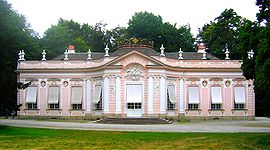
Amalienburg
Encyclopedia

Nymphenburg Palace
The Nymphenburg Palace , i.e. "Nymph's Castle", is a Baroque palace in Munich, Bavaria, southern Germany. The palace was the main summer residence of the rulers of Bavaria.-History:...
of Munich
Munich
Munich The city's motto is "" . Before 2006, it was "Weltstadt mit Herz" . Its native name, , is derived from the Old High German Munichen, meaning "by the monks' place". The city's name derives from the monks of the Benedictine order who founded the city; hence the monk depicted on the city's coat...
, southern Germany
Germany
Germany , officially the Federal Republic of Germany , is a federal parliamentary republic in Europe. The country consists of 16 states while the capital and largest city is Berlin. Germany covers an area of 357,021 km2 and has a largely temperate seasonal climate...
. It was constructed in 1734-1739 by François de Cuvilliés
François de Cuvilliés
François de Cuvilliés was a Belgian-born Bavarian decorative designer and architect who was instrumental in bringing the Rococo style to the Wittelsbach court at Munich and to Central Europe in general.Cuvilliés was so diminutive in stature that it was as a court dwarf he first came to the notice...
, in Rococo
Rococo
Rococo , also referred to as "Late Baroque", is an 18th-century style which developed as Baroque artists gave up their symmetry and became increasingly ornate, florid, and playful...
style, for the Holy Roman Emperor
Holy Roman Emperor
The Holy Roman Emperor is a term used by historians to denote a medieval ruler who, as German King, had also received the title of "Emperor of the Romans" from the Pope...
Charles VII
Charles VII, Holy Roman Emperor
Charles VII Albert a member of the Wittelsbach family, was Prince-elector of Bavaria from 1726 and Holy Roman Emperor from 24 January 1742 until his death in 1745...
and his wife, Maria Amalia of Austria
Maria Amalia of Austria
Maria Amalia of Austria was the younger daughter of Holy Roman Emperor Joseph I and Wilhelmine Amalia of Brunswick-Lüneburg...
.
Architecture
Most of the ground plan of the interior layout is given over to the round Hall of Mirrors in the center of the building which was designed by Johann Baptist ZimmermannJohann Baptist Zimmermann
Johann Baptist Zimmermann was a German painter and a prime stucco plasterer during the Baroque.Zimmermann was born in Gaispoint, Wessobrunn. He and his brother Dominikus Zimmermann were descended from an artist family of the Wessobrunner School...
and Joachim Dietrich (1690–1753). It creates an ethereal atmosphere in the Bavarian national colors of silver and blue.
Other rooms include the Blue Cabinet (the bedroom of the Electress) and the tiny palace also accommodates a kennel room for the hunting dogs. The kitchen is decorated with precious tiles from Delft
Delft
Delft is a city and municipality in the province of South Holland , the Netherlands. It is located between Rotterdam and The Hague....
which when put up, were mixed up when they were being laid by workers who thought they had the right order. The Castrol stove
Stove
A stove is an enclosed heated space. The term is commonly taken to mean an enclosed space in which fuel is burned to provide heating, either to heat the space in which the stove is situated or to heat the stove itself, and items placed on it...
(1735) constructed for the kitchen is a masonry construction with several fireholes covered by perforated iron plates. It is also known as a stew stove and the first design that completely enclosed the fire.

